Small Batch Fermentation:
Making Homemade Apple Cider Vinegar Using Scraps
There are many prepackaged items that are super simple to make and are healthier when homemade. A good example is Apple Cider Vinegar. It is easy to make, I can make it in small batches and use ingredients I have on hand. Small batch fermenting is a great way to make delicious and healthy food for you and your family.
I have been canning for the last 4 years and just started small batch fermentation. Both canning and fermenting has opened my eyes to how many things are really quite simple to make in your own kitchen. Foods such as jam, applesauce, pickles, apple cider vinegar, saurkraut, relish, tartar sauce… all are simple to make and don’t have to be done in large batches that would feed an army.
Why Make Homemade Apple Cider Vinegar?
- It is so easy, it tastes better, and it cheaper than buying organic, unfiltered store bought vinegars.
- Cooking: Use your homemade Apple Cider Vinegar in your recipes
- NOTE: Unless you have a reliable way to test the acidity level of your homemade apple cider it should not be used for canning purposes. When canning with Vinegar you want a specific acidity level and that level in store bought vinegar is tested and regulated.
- Homemade Apple Cider Vinegar is great for use in recipes and for drinking. It has amazing health benefits.
- Cleaning: Take advantage of apple cider vinegar’s antimicrobial properties. It has all the same benefits of cleaning with regular vinegar and water but I think it smells much better. Here is a good reference for details
- Health benefits: First a note: I am not a doctor. I recommend before using Apple Cider Vinegar for health benefits you do your research (through credible medical sources) and you talk to your physician. There are a ton of claims as to what benefits you can get from drinking Apple Cider Vinegar. If you google “apple cider vinegar health benefits” You will find a lot of people out there talking about why it is fabulous. However, these are the two major claims I have found to be also backed by medical research. In fact, many fermented foods help with these.
- It can help regulate blood sugars.
- This is not a full solution but can help. Read HERE on WebMD to explore the topic and the cautions you need to consider.
- According to Webmd “Carol Johnston, PhD, directs Arizona State University’s nutrition program. She has been studying apple cider vinegar for more than 10 years and believes its effects on blood sugar are similar to certain medications. “Apple cider vinegar’s anti-glycemic effect is very well documented,” Johnston says.”
- Probiotic benefits:
- Can help with Digestion, heart health and overall gut health.
- We have personally seen this benefit for ourselves.
- You want unfiltered apple cider vinegar (like what you make at home) for this benefit. The cloudy “blob” in unfiltered apple cider vinegar is called “the mother” and it’s full of probiotics and other beneficial bacteria.
- Note: Don’t drink it at full strength. Dilute it so the acidity doesn’t harm your tooth enamel or esophagus. 1-2 Tablespoons a day is plenty.
- It can help regulate blood sugars.
Perfect for small batch fermenting!
Lady and the Carpenter Vegetable Tampers
Made out of Maple and hand-turned. Each tamper is unique and beautiful.
With one end fitting in a regular mouth jar opening and the other fitting in a wide mouth jar opening they are the perfect tool for small batch fermenting.
How to make Small-Batch, Homemade Apple Cider Vinegar
You can a batch in any size. If you are just starting with a quart you will end up with about 2 cups vinegar.
Homemade Apple Cider Vinegar

Make your own Apple Cider Vinegar in your pantry. This simple ferment is full of beneficial probiotics. Super simple to make.
- Apples (peelings, cores, or whole apple chopped)
- Sugar (1 Tbsp. per 1 cup of water)
- Clean and sterilized jar (Quart size or larger)
- Vegetable Tamper (visit secure.ladyandthecarpenter.com for the perfect small batch tamper)
- Fermenting weight ( I use a sandwich bag with water)
- Coffee filter or fabric scrap that covers top of jar
- rubber band
- Fill your jar 3/4 of the way with apple peels and cores.
- Mix the sugar into the water until it’s mostly dissolved.
- Pour the sugar water over the apple pieces until they are completely covered. (Leave a few inches of room at the top of the jar.) Push apple pieces below the level of the water with a Vegetable Tamper.
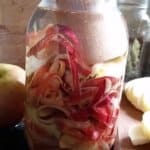
- Fill sandwich bag 1/4 full of water and place on top of apples to keep them from floating above the top liquid level (use more water in bag if needed. You can also use a tampering weight)
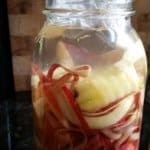
- Keeping the weight in place, loosely cover with a coffee filter or breathable fabric, secure with rubber band and set in a warm, dark place for around two weeks. (I put mine in the pantry and label the jar with a date for reference) You can give it a stir every few days, if you like. Also, if any white scum develops on the top, that is normal and an indication that it is doing what it is suppose to be doing.
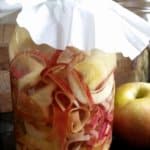
- Once two weeks has passed, strain the scraps from the liquid. You can discard the scraps into your compost or feed them to your chickens.

- Put that beautiful liquid back in the jar and place it back into your warm, dark place for 4-5 weeks. Time to now wait for that lovely vinegar tang to show up. After the first 4 weeks, you can begin to taste your vinegar. Once it reaches an acidity you like, you can transfer it to a bottle with a lid, refrigerate it and begin using it.
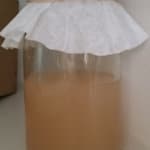
You can find our Vegetable Tamper at Lady and the Carpenter Store. Perfect for small batch fermenting with one side fits perfectly in a regular mouth mason jar and the other side fits perfectly in a wide mouth jar.
Recipe from Lady and the Carpenter
NOTES:
- You can a batch in any size. If you are just starting with a quart you will end up with about 2 cups vinegar.
- I use apple scraps after I prepare apples for the kids. The peels and core of about 4 apples fill a quart jar. So, I use my apple corer/peeler/slicer to prep enough for all to eat (or make applesauce out of) then the scraps go into a jar and another ferment begins. I label my jars with a date so I know when different batches began.
- Apples are on the Dirty Dozen List for produce that has the highest level of pesticides present when tested. Therefore, Picking apples that are organically grown is an important consideration. If you are going to make something healthy for yourself it is a bit counter-productive to put pesticides in it.
So, What is next in my small batch fermenting adventures….
Homemade Sauerkraut! Yum!
Need a great fermenting book? Come read Fermenting Food Adventure Begins and Fermenting Book Review
Come visit our store to find simple and gorgeous wood household items. All made in the US

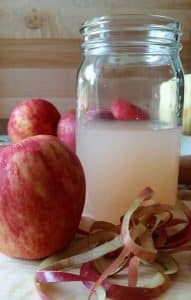

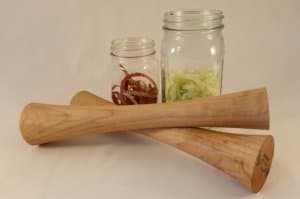





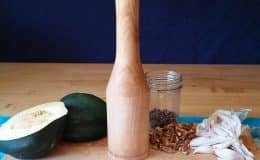
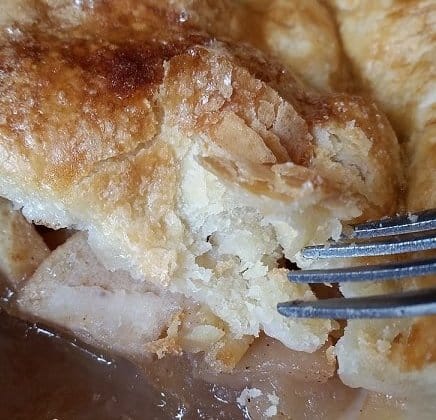
Abhijit
January 7, 2019 6:31 pmAwesome work
like the way you have simplified it